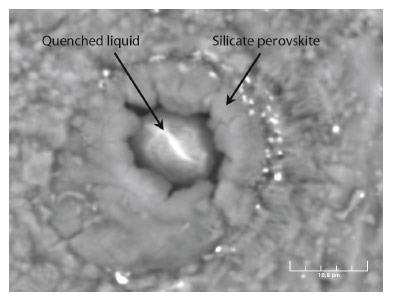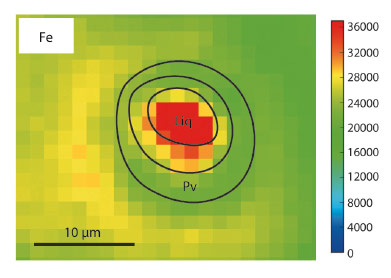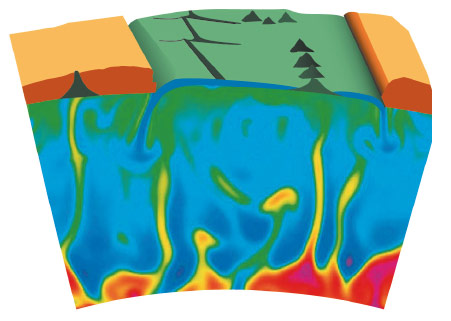- Home
- Users & Science
- Scientific Documentation
- ESRF Highlights
- ESRF Highlights 2012
- Dynamics and extreme conditions
- X-rays illuminate the origin of volcanic hotspots
X-rays illuminate the origin of volcanic hotspots
Melting processes in the deep Earth’s mantle may be the origin of the deep-derived plumes believed to feed hotspot volcanoes such as those in Hawaii. Zones in the lowermost mantle where seismic waves have ultra-low velocities have been interpreted as indicative of partial melting [1]. Between 5% and 30% partial melting could reduce the velocities of P and S seismic waves in agreement with seismological observations. The consequences of partial melting on the formation of distinct geochemical reservoirs could be major. Nevertheless, it is the density contrast between solid and melt fractions that controls the dynamic behaviour of the deep, partially molten mantle. Ascent or descent of liquids can have drastically different geodynamical consequences such as surface volcanism or production of a deep magma ocean, respectively.
We carried out experiments at beamlines ID27 and ID21 to determine the liquid buoyancy in the deep mantle. We used synthetic samples of chondritic composition, which is believed to be the most suitable for the deep and primitive mantle. After compression to target pressures between 40 GPa to 120 GPa, samples were heated by two infrared lasers with a spot diameter of more than 20 µm. Melting of our samples was then achieved at temperatures up to 4,150 K. Temperatures were measured by analysing the pyrometric signal emitted over a sample area of 3 µm × 3 µm. Melting criteria are based on the use of in situ X-ray diffraction [2].
 |
|
Fig. 30: Electron photomicrograph of a sample recovered after synthesis at 55 GPa and 2900 K. At the centre, the molten region is about 10 µm in diameter. |
We analysed the recovered samples using simultaneous X-ray diffraction (XRD) and X-ray fluorescence (XRF), generating XRD and XRF maps with resolutions down to around 500 nm. XRD analyses revealed circular zoning in the laser hotspot: the centre contained the quenched liquid, as evidenced by the presence of several phases. The surrounding band of minerals consisted exclusively of aluminium-bearing (Mg,Fe)SiO3 perovskite (Mg-Pv), the most refractory phase in the lower mantle (Figure 30). From the XRF maps, we obtained the iron partition coefficient (DFe) between the two different regions. DFe was between 0.45 and 0.6, indicating that iron was roughly twice as concentrated in the liquid compared to solid Mg-Pv (Figure 31). Our findings contrast strongly with a previous study suggesting a liquid 10 times more concentrated in Fe compared to Mg-Pv, at the core-mantle boundary pressure of 135 GPa [3]. This discrepancy could be attributed to the difference in composition of the starting materials: olivine in the previous study and an aluminium-bearing silicate glass in the present one. Furthermore, our samples were sufficiently thin to avoid any additional manipulation after their synthesis, while in the previous study the samples were thicker and may have encountered larger thermal gradients; they were also cut into slices for electron microprobe analyses.
 |
|
Fig. 31: Spatial distributions of the Fe XRF-intensity for the sample synthesised at 78.5 GPa and 3650 K. The intensity in the liquid (Liq) is about twice that in the silicate perovskite (Pv). |
On the basis of thermodynamic calculations [4], our results provide evidence that melt generated at the core–mantle boundary should be buoyant, and hence should segregate upwards. This observation gives support to the theory that volcanic hotspots like the Hawaiian Islands originate from mantle plumes at the Earth’s core-mantle boundary (Figure 32). The results of the experiment are also of great significance for the understanding of the early history of the Earth. Within the hypothesis of magma oceans induced by large meteoritic impacts on the early Earth, our results suggest that magma crystallisation should push the liquids towards the surface and form a deep solid residue depleted in incompatible elements.
 |
|
Fig. 32: Illustration of mantle plumes from the core-mantle boundary region reaching the Earth’s crust. Due to the lateral displacement of the tectonic plates at the surface, the mantle plumes can create a series of aligned hot spot volcanoes. |
Principal publication and authors
D. Andrault (a), S. Petitgirard (b), G. Lo Nigro (a), J.-L. Devidal (a), G. Veronesi (b), G. Garbarino (b) and M. Mezouar (b), Nature, 487, 354-357 (2012).
(a) Laboratoire Magmas et Volcans, Université Blaise Pascal, CNRS, Clermont-Ferrand (France)
(b) ESRF
References
[1] T. Lay, E.J. Garnero and Q. Williams, Physics of the Earth and Planetary Interior 146, 441-467 (2004).
[2] D. Andrault, N. Bolfan-Casanova, G. Lo Nigro, M.A. Bouhifd, G. Garbarino and M. Mezouar, Earth and Planetary Science Letters 304, 251-259 (2011).
[3] R. Nomura, H. Ozawa, S. Tateno, K. Hirose, J.W. Hernlund, S. Muto, H. Ishii and N. Hiraoka, Nature 473 199-202 (2011).
[4] N. Funamori and T. Sato, Earth and Planetary Science Letters 295, 435-440 (2010).



